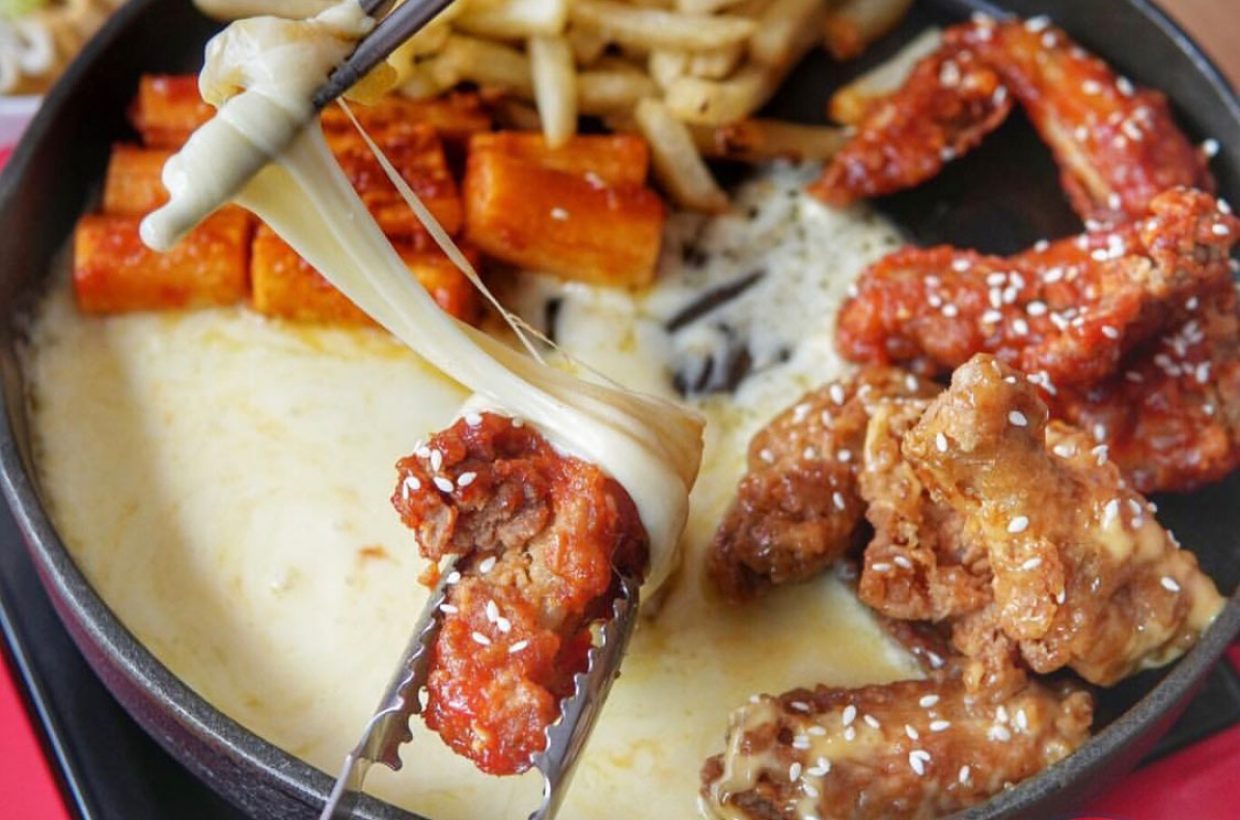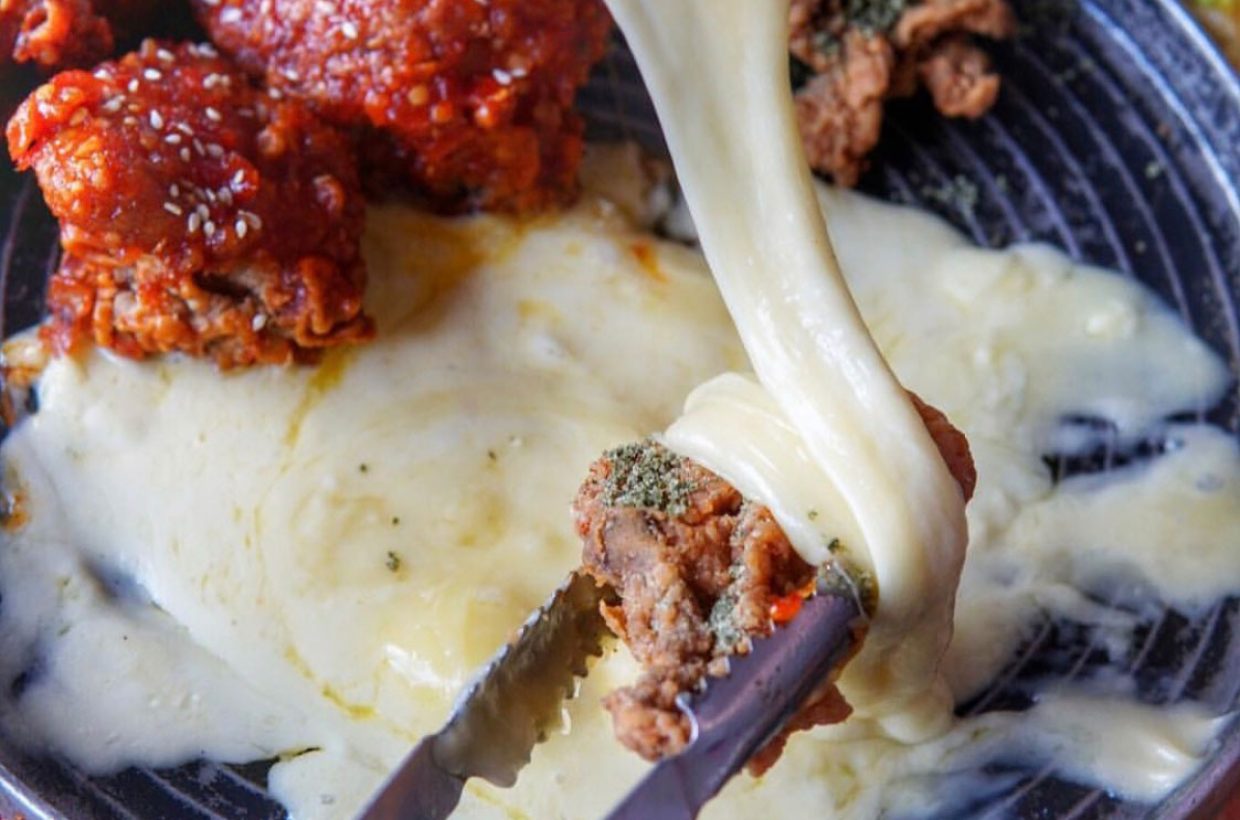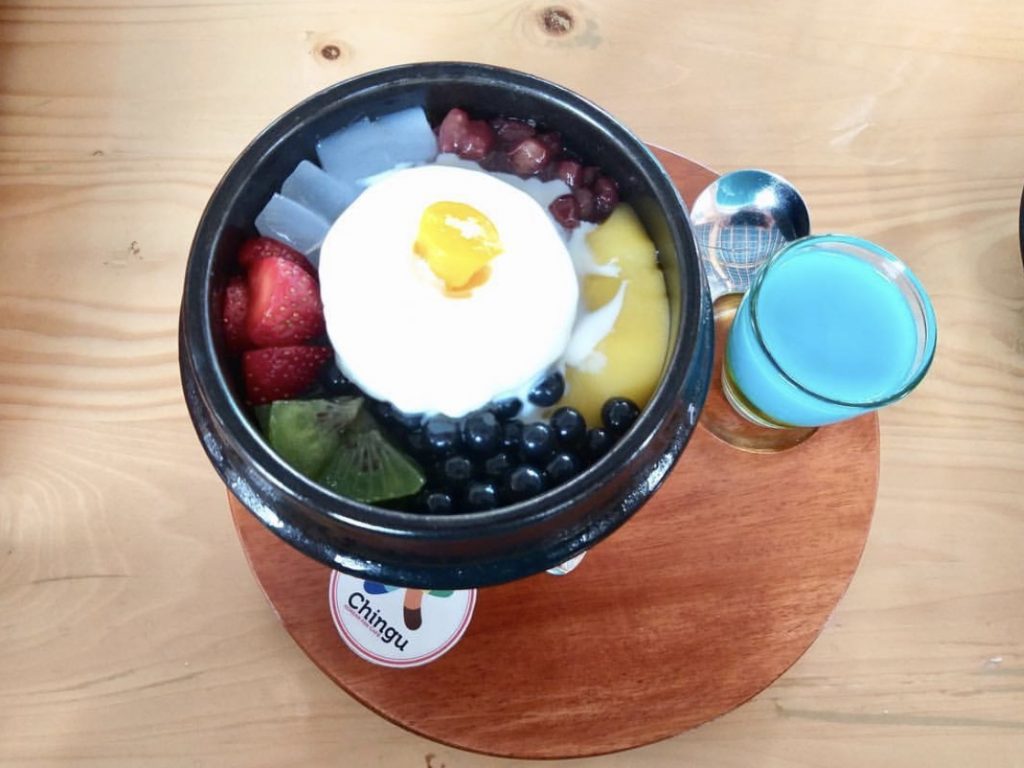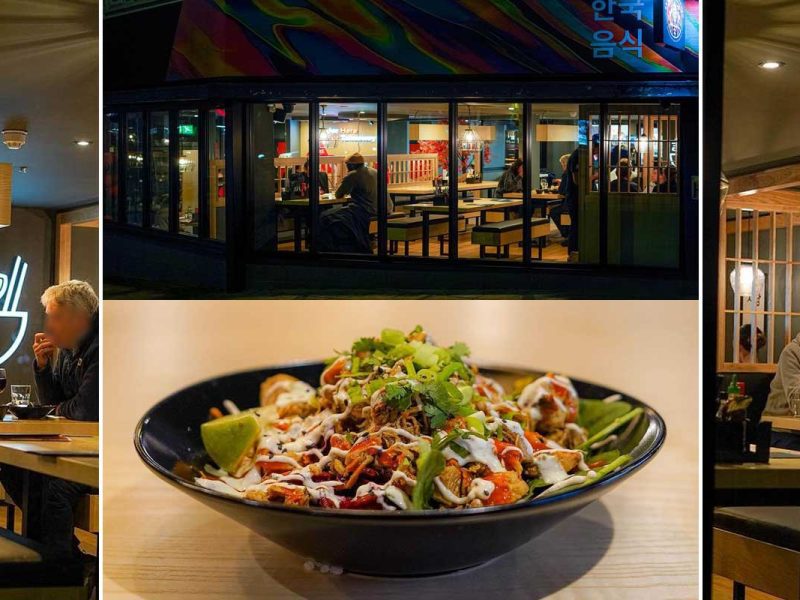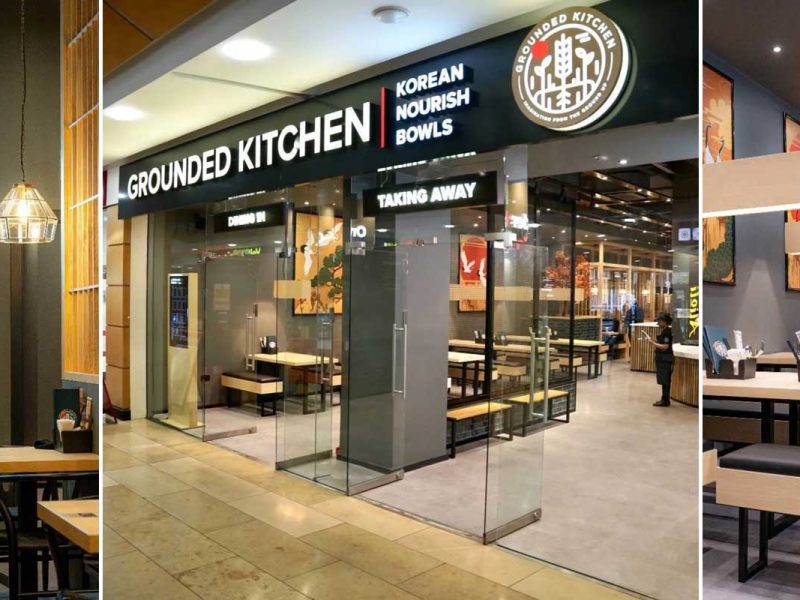Chingu Fan Café (Korean) – Indonesia
 Having recently opened their second Indonesian branch in Yogyakarta, Chingu Korean Fan Café sets to recreate the famous districts of Seoul; making it an Instagrammer’s dream.
Having recently opened their second Indonesian branch in Yogyakarta, Chingu Korean Fan Café sets to recreate the famous districts of Seoul; making it an Instagrammer’s dream.
Complete with a mini lake, Hanbok dress-up area, bridge and seating arrangements disguised as movie theatres, tea houses, fried chicken cafes and dessert shops, there is truly something for every fangirl here.
Sincerely living up to its name ‘fan café’, this place is themed around KPOP, with memorabilia, names of drinks, décor, music, and even phrases expressed by staff, used in celebration of this genre of popular music that first originated in South Korea.
It goes without saying, therefore, that this eatery is fashionable with young female students. Even the food prices in the menu, which itself resembles a Vogue magazine, are in Korean Won (W) to give diners a true authentic Korean feel.
And while these prices will require conversion to Indonesian Rupiah (1 W = 10 IDR), most dishes are very affordable for even the humblest of fan girls.
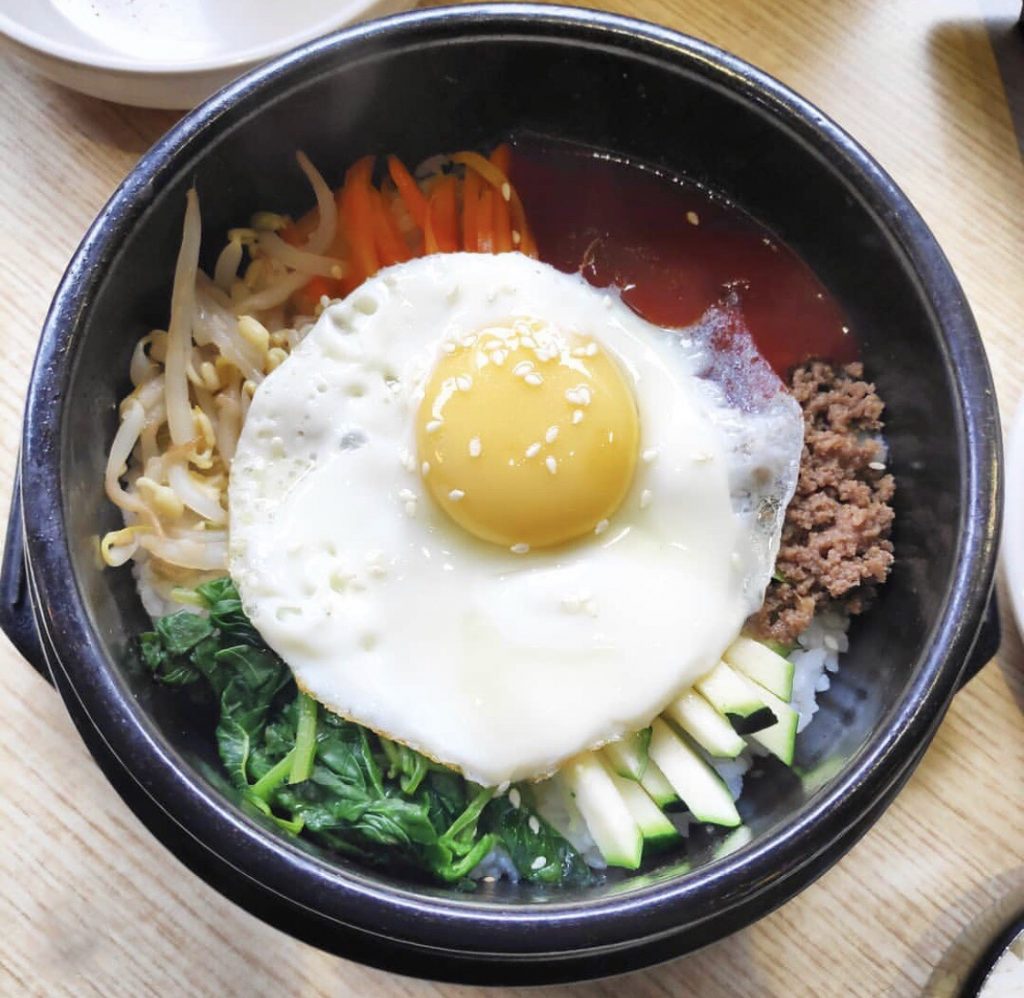
Bibimbap – Rice topped with ground meat, raw julienned carrots and veggies, gochujang (Korean fermented spicy chilli sauce), bamboo shoots and topped with sesame seeds and a fried egg; served in a warm cast iron bowl, 2690W/26.9K IDR
In Korean, ‘Bibim’ means to mix and ‘bap’ means rice; thus the traditional way to eat a bibimbap is to break the soft egg yolk with your utensils, before stirring it through the rice and toppings to create a mixed stir-fry in your bowl.
The egg was cooked sunny-side up, with a soft mushy yolk that was also on the right side of runny. When mixed with the other components, this created a thick glossy sauce, which added a savoury note to things.
While the rice was cooked well, the ground beef was disappointing – a little cold, greasy and gritty. The glob of gochujang sauce that veiled the rice on the other hand, was truly the star of this show. Spicy, sweet, deep and rich from the months of fermenting the rice and chillies, this vegan sauce was as good as the ones we’ve tried in Korea.
Overall, the dish was simple yet substandard, with the pizzaz and flavour being generated from a jar of gochujang sauce.
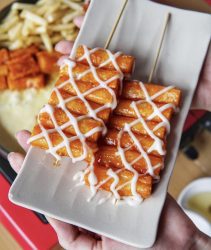 Arriving on a cast iron plate came three pieces of Korean fried wings with herbs, three pieces of spicy Korean wings, mozzarella balls, French fries and tteokbokki (Korean rice cakes).
Arriving on a cast iron plate came three pieces of Korean fried wings with herbs, three pieces of spicy Korean wings, mozzarella balls, French fries and tteokbokki (Korean rice cakes).
The dish was placed atop a mini cooker on our table, with no instructions given on how to eat or cook, prompting us to use our initiative. After fiddling with the gas cooker, we patiently waited for the mozzarella to melt and the rest of the food to heat up. Note: You must keep the heater on to keep the cheese melted, while constantly stirring; otherwise, it’ll develop a crust underneath.
Thanks to the cooking process, the soft and chewy cylindrical rice cakes (tteokbokki) acquired a crispy bottom, while being crunchy in places on the outside, and chewy, doughy and soft on the in.
In fact, this rice cake was one of the better ones we’ve tasted, reminding us of hard uncooked mozzarella cheese.
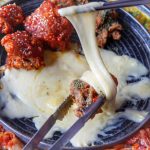 In addition, this common street food was lashed in a gochujang based sauce, which began as sweet before giving way to the gradual hit of the fiery chilli.
In addition, this common street food was lashed in a gochujang based sauce, which began as sweet before giving way to the gradual hit of the fiery chilli.
Koreans take their chicken seriously, to the point where even KFC is known to stand for Korean Fried Chicken. We were, thus, looking forward to trying these wings. And the flavours really didn’t disappoint at all!
Gochujang was the star of the show once again, creating the glaze for the fried wings. The red sauce, caramelised upon cooking, created a sweet, sticky and spicy glaze. The flour dredge was seasoned well and fried ‘til crispy and crunchy. The meat itself was particularly overcooked and tough, however, which we found surprising given that the wings arrived cold.
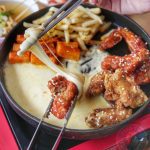 The best thing about this dish was the glaze, which coated your fingers too; meaning extra flavour once your chicken was finished. Goals!
The best thing about this dish was the glaze, which coated your fingers too; meaning extra flavour once your chicken was finished. Goals!
The second variety of wings were cooked well; but again remained quite cold even after being heated on the stove. They had almost as much flavour as the previous wings, with the dredge being seasoned perfectly and sprinkled with a green powder, which we presumed to be seaweed. This added an umami, salty and deep flavour, which was delicious!
The fries were cold and hard, and were left where they lay.
In all, it’s obvious that this dish was conceived to both please the eye while creating a wow factor that would prompt people to snap away with their phones. In short, this dish was more theatrical than flavoursome.
Famed for being Korea’s no.1 takeaway dish, we were looking forward to this unusual Jajangmyeon which is famed for serving semi-cold noodles topped, in this case, with a thick black soy bean sauce containing small pieces of meat, and sprinkled with cucumber matchsticks.
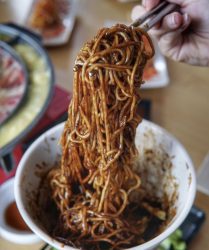 Despite the noodles being plain, unseasoned and uninteresting, the sauce was distinct, turning out to be extremely thick and umami from the very first bite. The familiarity of soy sauce shone through; almost as if they had cooked it down in a pan and thickened it with cornstarch.
Despite the noodles being plain, unseasoned and uninteresting, the sauce was distinct, turning out to be extremely thick and umami from the very first bite. The familiarity of soy sauce shone through; almost as if they had cooked it down in a pan and thickened it with cornstarch.
We definitely picked up notes of ‘black bean sauce’ therein (the Chinese variety), which made sense, as the sauce is made from the same fermented douche (black soybeans).
The flavours were extremely rich and complex, but nothing which western palates would be used to (i.e. spicy, tangy, sweet or bitter); just really deep, savoury umami notes.
The beef was cut into indiscernible pieces and scantily decanted into the sauce. The julienned cucumber topping was a clever addition, however, helping to cut the richness of the sauce with each given mouthful.
Certainly an interesting eat, but with room for improvement, we’d conclude.
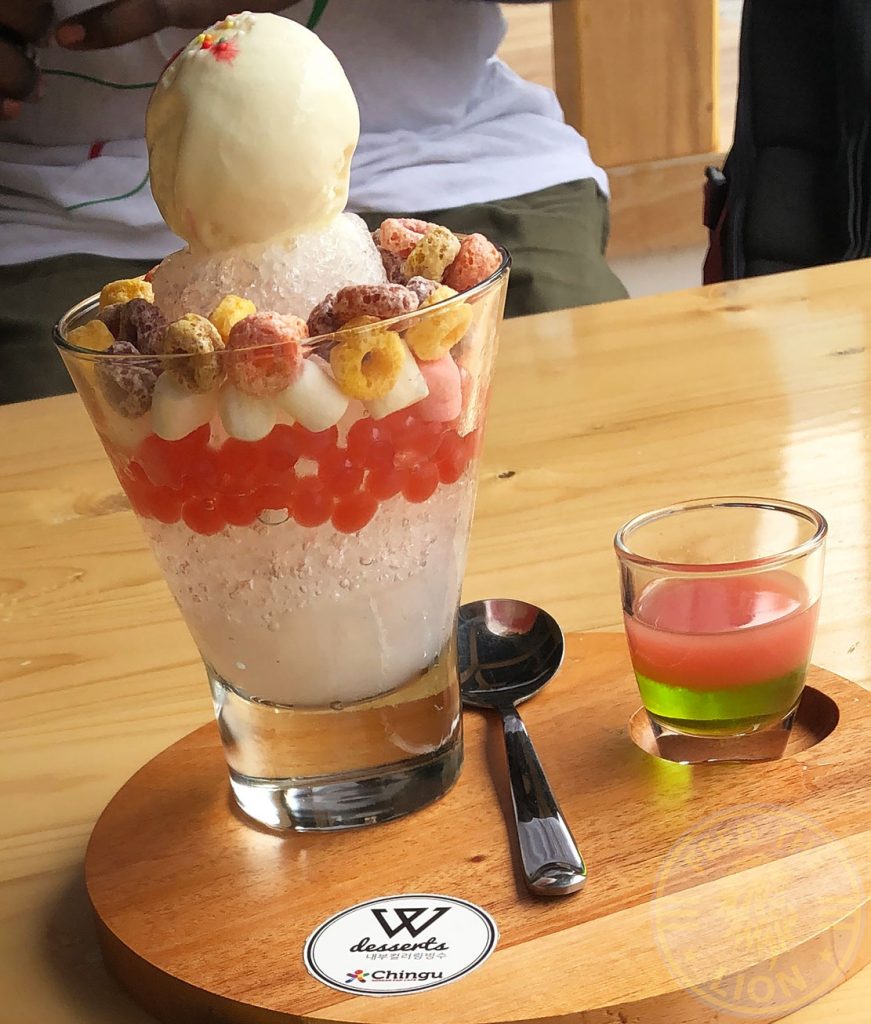
Inner Colour Ring Bingsu Dessert – ice served with vanilla ice cream, popping boba and pearls, fruit loops, halal marshmallows, and garnished with a banana and honeydew melon syrup, 2340 W/ 23.4K IDR
While this Inner Colour Ring Bingsu Dessert looked like an Instagrammer’s dream, it turned out to be a tricky eat, what with the ice being more a block rather than being shaved.
The toppings gave wonderful texture, however, with crunch, pops, chews and melts; whilst the syrup added atop made everything taste tooth-achingly artificial and sweet. The warm Indonesian sun made the contents melt very quickly, fast turning it into a fun milkshake!
The Bing Soo looked visually appealing; playing on the popular bibimbap rice dish. It was presented like a bibimbap and served in a clay pot (not warm of course), with shaved ice ‘rice’.
Topped with popping jelly, kiwi, strawberries, tapioca pearls, red beans, coconut squares and egg custard jelly toppings, this was garnished with an imitation ‘fried egg’ made from vanilla ice cream and a mango pudding resembling the yolk. To add even more wow factor, the dish can be embellished with an electric blue syrup.
It tasted similar to the Inner Colour Ring Bingsu above – very sweet, with good textures. However, it had the same artificial sweetness which some may enjoy.
We tried the signature mikt tea drinks – milk tea with strawberry pearls, and chocolate milk with egg custard jelly peices. And although these were called teas, they tasted more like sweet flavoured milk.
The addition of the pearls/soft squares were pleasant enough adding a lovely texture and a touch of fun to the whole thing – of course, exactly the feeling that Chingu Fan Café was going for.





